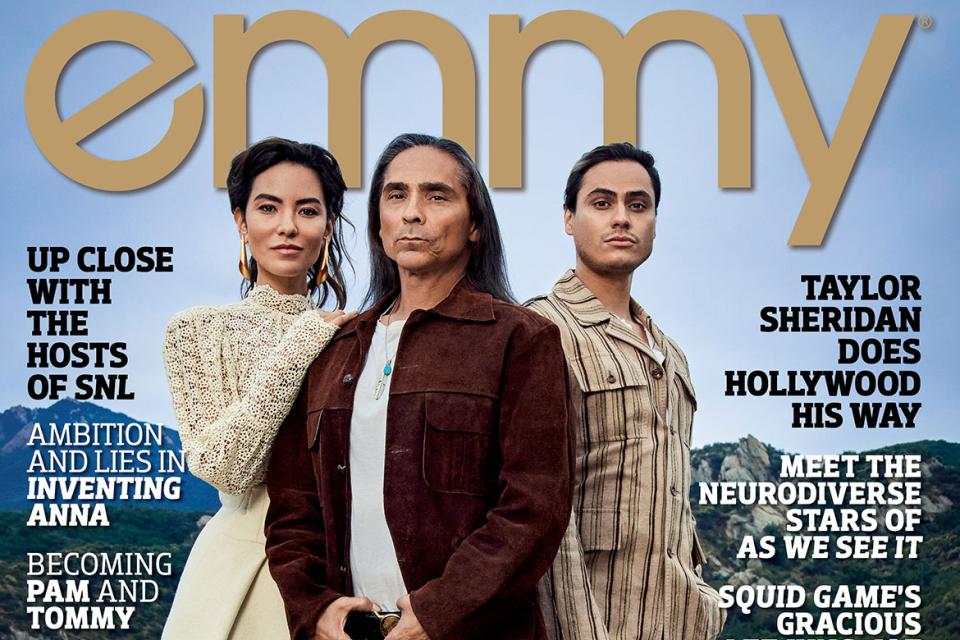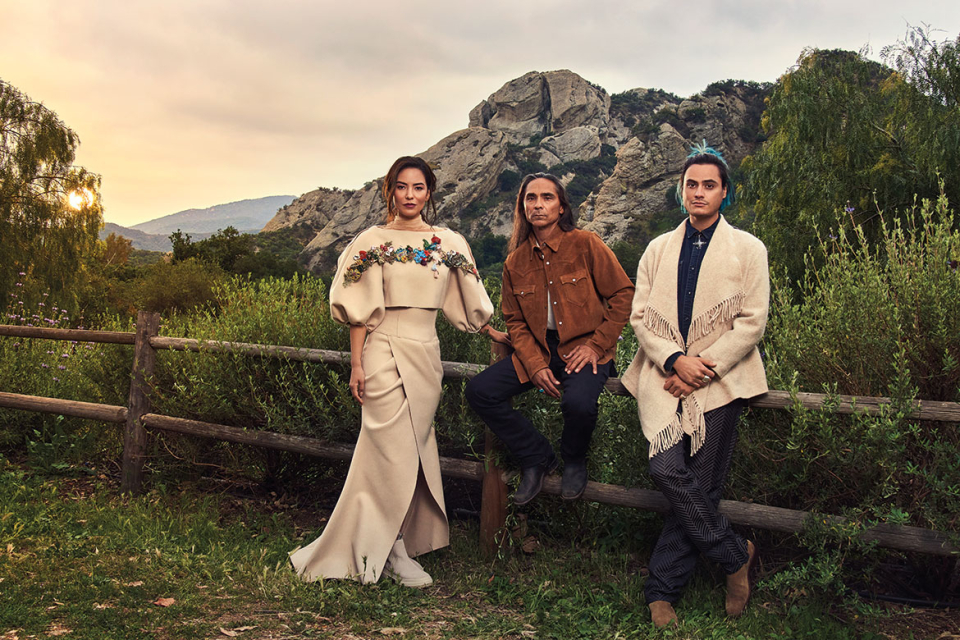Picture this: Two cops have set out to question a suspect holed up in a remote rural shack.
Things go sideways and bullets start flying. "Little do we know, they have backup hidden in the hills — a sniper with us in their sights," says Kiowa Gordon, who plays Jim Chee, one of the officers. "It was a lot of fun," agrees Zahn McClarnon, who plays Joe Leaphorn, the other officer. "Kiowa was very excited, running around like a little kid."
Not only were the two actors thrilled to be given such an intense action scene — where they could kick in doors, run up rocks, roll around in the dirt and dodge (fake) bullets as glass shattered and tires blew up — but doing so felt like a long-overdue role reversal. "It's almost like an old-fashioned Western shootout," Gordon says. Except, McClarnon adds, "This was not cowboys and Indians. It was Indians and Indians this time."
The confrontation — which required two days to shoot, three cameras and forty setups on New Mexico's Cochití pueblo — takes place in AMC's new drama Dark Winds, debuting June 12. Set in the rugged landscape of the Southwest's Four Corners region (where Colorado, Utah, Arizona and New Mexico meet), the show is based on a long-running series of bestsellers by the late Tony Hillerman. His main characters? Navajo tribal police officers Leaphorn and Chee.

These are no ordinary procedurals — the crimes Leaphorn and Chee investigate take place in a closed society. If federal agents are called in, it's more than just a jurisdictional turf war; a joint investigation is loaded with cultural and historical tensions.
The crimes themselves — sometimes seeming to involve the spirit world — require more than logic and deduction to solve. They require an understanding of ancient myths and traditional ceremonies as well as a deep familiarity with the local Navajo residents, their complex clan relationships and their beliefs and customs, especially when it comes to the dead. No white FBI agent could put together the clues and investigate the way Leaphorn and Chee can.
Appropriately enough, the series is substantially staffed by Indigenous talent in front of and behind the camera — including, of course, the stars: McClarnon's tribal affiliation is Hunkpapa Lakota Sioux and Gordon's is Hualapai. "It feels like we are in a great time now on television," says creator and executive producer Graham Roland (Chickasaw) "where you can tell stories like this in really big productions, set in diverse worlds, in a really spectacular way."
Robert Redford, also an executive producer, observes: "It was important for the storytelling to honor the material, especially as it relates to the depiction of the Native American people and their culture. Authenticity is key, and I believe the team has done that while also creating a compelling series that is filled with mystery and suspense."
And don't forget the action. "The helicopter, the car chases, the explosions — it's a big action show," showrunner and executive producer Vince Calandra says. "There's a big action set piece in almost every episode."
Where did Leaphorn and Chee leap from? Every Tony Hillerman adaptation that's made it to the screen so far (this isn't the first) has brought Leaphorn and Chee together right away. Otherwise, it would be like watching Scully or Mulder work solo. (That duo's paranormal sleuthing, by the way, owes a significant debt to Leaphorn and Chee's skeptic-believer pairing.) But when Hillerman started his book series in 1970, Leaphorn did work alone. Had it not been for some of the legal entanglements around bringing the novels to the screen over the years, Chee wouldn't exist at all.

Warner Bros. optioned the first novel (1970's The Blessing Way) and an independent production company took on the second (1973's Dance Hall of the Dead). NBC considered turning Leaphorn's investigations into a series — like Hawaii Five-0, but in the desert — but discussions stalled after execs expressed a desire for Leaphorn to be something other than a Navajo tribal police officer. Since he'd sold the continuing rights to the Leaphorn character, Hillerman decided to create a new investigator: Jim Chee.
As seen in Dark Winds, Leaphorn and Chee have similar pedigrees, even if their personalities differ. Both are members of the same small tribal police force. Both studied anthropology at university and have deep knowledge of the Navajo cultural heritage. Like Leaphorn, Chee worked alone at first, but Hillerman bought back the rights to the Leaphorn character in time to use him for the seventh book in the series, 1986's Skinwalkers. That's when Leaphorn and Chee finally met and joined forces, and when Robert Redford first read Hillerman and snapped up the rights.
He had a vision for the story — he just didn't realize it would take some thirty-five years to realize it. "My history with Tony's work runs deep," Redford notes.
His first attempt to launch a film franchise was with 1991's Dark Wind, which Errol Morris directed. But Navajo and Hopi groups protested the casting (part-Cherokee Lou Diamond Phillips as Chee) and the depiction of culturally sensitive traditional ceremonies, and they denied permission to shoot on tribal lands. The film got made, but it went straight to video.
A few years later, Redford was dazzled by a young talent named Chris Eyre (Cheyenne, Arapaho). It was at Redford's Sundance Institute Director's Lab that Eyre had developed his award-winning directorial debut, 1998's Smoke Signals, which became the first feature film written, directed and produced by Indigenous people to reach a mainstream audience. (It also sparked a "Frybread Power" T-shirt craze).
"From there, a friendship grew," Redford says. "Over the years, we've had opportunities to discuss our thoughts and ideas for the series."
Eventually, they found a starter home for it at PBS and turned the material into a series of telefilms, with Wes Studi as Leaphorn and Adam Beach as Chee. The first film, 2002's Skinwalkers, drew 12 million viewers and became the highest-rated PBS offering of the year. It also featured a preteen Kiowa Gordon, who had an uncredited walk-on role. Then-Chee and future-Chee met up and hung out during downtime.
"All I remember is that I was super stoked to play Halo with Adam Beach," Gordon says. "And now here I am, twenty years later, doing Jim Chee!"
Read this article in the digital edition of emmy.
To read the rest of the story, pick up a copy of emmy magazine HERE.
This article originally appeared in its entirety in emmy magazine, Issue No. 6, 2022.












